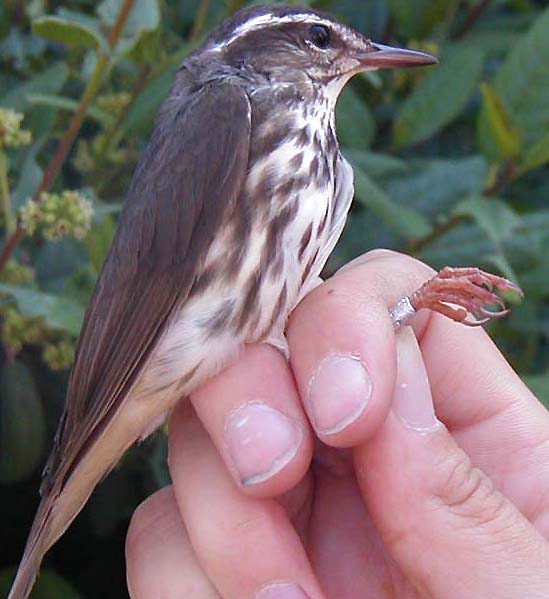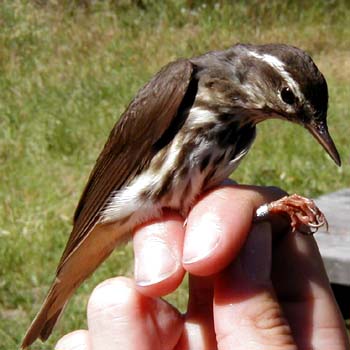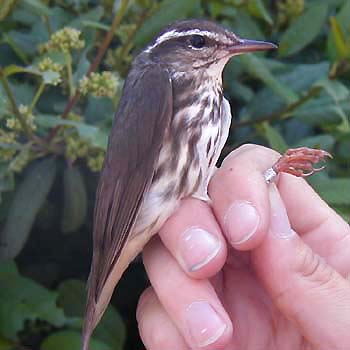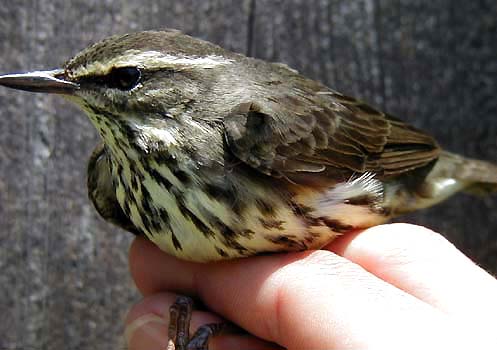BIG SUR ORNITHOLOGY LAB: Louisiana Waterthrush
Seiurus
motacilla
 |
On May 30, 2003, banders at Big Sur Ornithology Lab (BSOL) captured
this waterthrush. Characters that suggested Louisiana were: bright buffy
undertail coverts and rear flanks, contrasting with otherwise bright white
underparts; a long white supericilium that broadened behind the eye; a
largish bill and largish size (measurements in overlap zone but near the
extreme large end for Northern); unspotted white chin and throat; broad
heavy spots on clear white underparts rather blurry and not in rows; bright
pink legs; and small grayish centers to longer undertail coverts (rather
than blackish bases to those feathers). |

|

|

|
These details are recorded on the banding log:
capture time: 0950 (net 3A)
weight: 221
wing: 77 mm
age: AHY by plumage
no molt; fat = 4; no signs of breeding
"undertail coverts w/small grayish centers, large bright supercilium;
chin & throat without streaking; underparts bright white contrasting
with buffy undertail coverts; nares to tip = 10.5 mm"
[bander = Jessica Griffiths]
|
| For comparative purposes, this photo of a Northern Waterthrush S.
noveboracensis was taken at BSOL on 6 May 2003 (photo by Sarah Hamilton).
Characteristics typical of Northern and shown in this photo include spotted
throat, yellowish wash to underparts; whitish undertail coverts, white
supercilium that narrows behind eye, slimmish bill, and more densely spotted
underparts in a more orderly pattern of lengthwise rows. |
 |
FIELD OBSERVATION (notes from Don Roberson): "This waterthrush
was banded about 10 a.m. and released. I received a phone call at about
noon, was at Andrew Molera SP by 12:40, and the bird was relocated about
1 p.m. It was first relocated by BSOL interns Robin Hunnewell and Eric
Miller as they were wading upstream knee-deep from the bridge at the parking
lot towards the BSOL bridge. I was standing on the upper bridge and they
relayed the message via handheld intercom to Jessica Griffiths, who was
with me. I immediately waded downstream and met them. The bird had flushed
into the riparian edge but we waited and eventually a waterthrush zoomed
by us and downstream, landing on a horizontal branch overhanging just over
the water surface. [The Big Sur River was still running strong with quite
a current .... a regular rushing torrent!]
Here the bird began exaggerated bobbing, appreciably
slower and deeper than what I expect with Northern Waterthrush, and in
a circular or semi-circular motion. It seemed to be putting the whole rear
end of the bird into this circular motion with each bob. The bird seemed
largish for a waterthrush, and long-legged; the legs were pink. The bird
was facing away from us, so details of the head could not be seen, but
the undertail coverts all appeared to be washed with a deep, rich buff
color. Otherwise the waterthrush was dark brown above and white below with
heavy spotting on the breast.
The bird seemed very shy and skittish, and our views
were from a fair distance. After perhaps a minute, the bird walked to the
bank and dropped down out of sight. A few moments later I saw it in flight
again, going downstream and around a corner. It did not call." We walked
to a spot where we could see the lower bridge, and then Eric hiked around
via land and then waded upstream from there. The bird did not flush; we
presume it most have kept on going downstream the first time, or up into
the riparian. Efforts throughout the afternoon failed to locate it.
PHOTOS: All photos © 2003 Big Sur Ornithology Lab, used
with permission; all rights reserved. The Louisiana Waterthrush photos
of 30 May 2003 were taken by Jessica Griffiths.
TOP
TO HOME PAGE
TO
MOUNTY COUNTY LIST PORTAL
TO LIST OF BIRD
FAMILIES OF THE WORLD
TO IDENTIFICATION
PAGE
TO MONTEREY PAGE
Page created 30 May 2003




